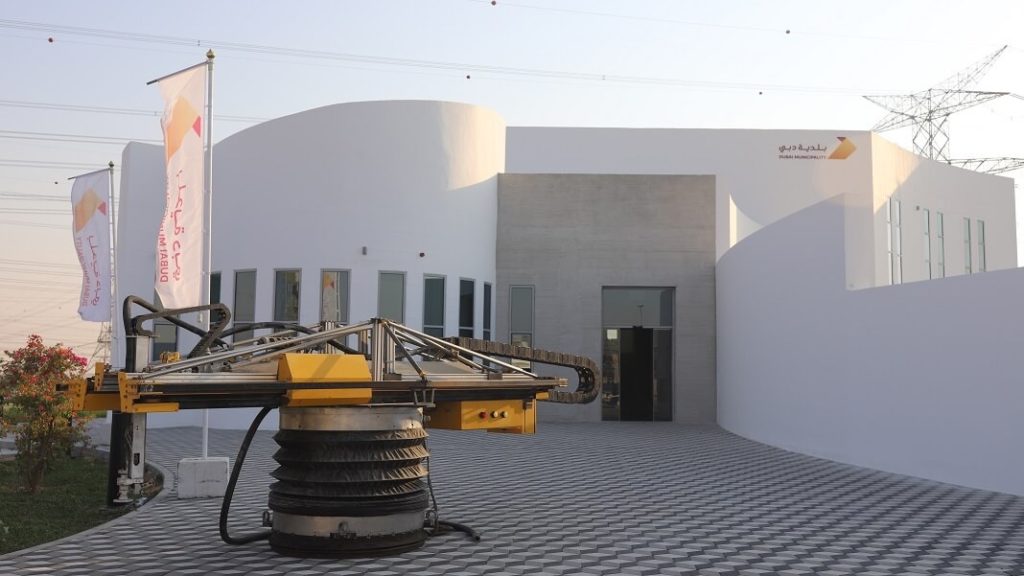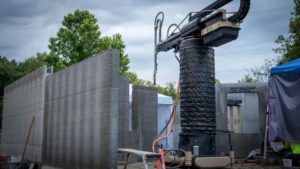This week, additive construction (AC) hit a major milestone. It had little to do with any development to the technology itself and more to do with public policy: Montana became the first US state to give broad regulatory approval for 3D printed concrete walls.
Tim Stark, a general contractor, applied for and received permission from Montana’s Department of Labor and Industry (DLI) to use printed concrete walls as an equal replacement for standard concrete masonry units (CMUs) — basic concrete blocks. Stark will be using a method created by Apis Cor, an AC firm based in Florida.

In a press release, Stark commented, “I’m proud of my home state Montana for being so forward-thinking and leading the way with this approval of 3D printing as a modern construction method on par to CMU block construction, which opens the door instead of closing it.” Montana’s DLI Commissioner, Laurie Esau, asserted, “The department will continue to work to ensure that our standards and regulations are keeping pace with the innovation taking place in the industry to help facilitate new construction for Montana’s workers and families.”

Apis Cor’s process relies on concrete extrusion achieved with a nozzle controlled by a robotic arm, rather than by a gantry, which is far less common than gantry concrete printing. Without getting into any exact numbers (for one thing, because I don’t know them), the Danish company COBOD, which makes a gantry-based machine, represents well over half of the AC sector. It seems notable, then, that this particular process is the first to get broad state-level approval.
In any case, the significance of this particular “first” is more than just symbolic. In a Forbes interview with 3DPrint.com’s editor-in-chief, Michael Molitch-Hou, Stephan Mansour — a consultant at Wohlers Associates who specializes in AC — pointed out, “Nothing in construction happens without standards. …Standards enable mass adoption and acceptance…which encourages further developments in materials and approaches, and enables competitive pricing.” Thus, it should now be much easier than it was previously for both this as well as other AC processes to gain the approval of regulators, not just in Montana, but in other states, as well. And, generally, the climate seems favorable for the sector’s success.

For instance, although this isn’t quite the same as formal approval from building regulators, Iowa’s junior US senator, Joni Ernst, held a public event (also this week) near one of Alquist 3D’s build sites, in Stanton, Iowa. While talking to local radio station KMALand, Ernst not only praised the technology, but was actually able to repeat boilerplate industry statistics in its favor: “Especially when you produce in scale, so they said 20-30 homes across maybe a county, …[the cost savings] could be up to 30% versus stick-home type houses.”
However, it is worth noting that ASTM International has been awarded $300,000 funding from the U.S. Department of Commerce’s National Institute of Standards and Technology (NIST) to establish a roadmap for the use of advanced manufacturing in construction. This includes AC, robotics and automation, big data, and artificial intelligence.
Finally, while I don’t know what this particular builder has in mind, it’s worth mentioning that high energy prices are currently leading to increased drilling activity in the Bakken oil formation. Most of Bakken is in North Dakota, but some of it is located in northeastern Montana. The boom-bust cycle of the oil sector left the communities affected economically devastated, following the last sustained boom period there in the early 2010s. It’s impossible to say how long the increased activity will last this time. However, production on demand —facilitated by technologies like AC — could be an insurance policy against falling into the same old trap of rapid over-investment, leading to inevitable collapse.
Images courtesy of Apis Cor
Subscribe to Our Email Newsletter
Stay up-to-date on all the latest news from the 3D printing industry and receive information and offers from third party vendors.
You May Also Like
Gorilla Sports GE’s First 3D Printed Titanium Cast
How do you help a gorilla with a broken arm? Sounds like the start of a bad joke a zookeeper might tell, but it’s an actual dilemma recently faced by...
Nylon 3D Printed Parts Made More Functional with Coatings & Colors
Parts 3D printed from polyamide (PA, Nylon) 12 using powder bed fusion (PBF) are a mainstay in the additive manufacturing (AM) industry. While post-finishing processes have improved the porosity of...
$25M to Back Sintavia’s Largest Expansion of Metal 3D Printing Capacity Since 2019
Sintavia, the digital manufacturing company specializing in mission-critical parts for strategic sectors, announced a $25 million investment to increase its production capacity, the largest expansion to its operations since 2019....
Velo3D Initiates Public Offering in a Bid to Strengthen Financial Foundations and Drive Future Growth
Velo3D (NYSE: VLD) has been among a number of publicly traded 3D printing firms that have attempted to weather the current macroeconomic climate. After posting a challenging financial report for 2023,...































